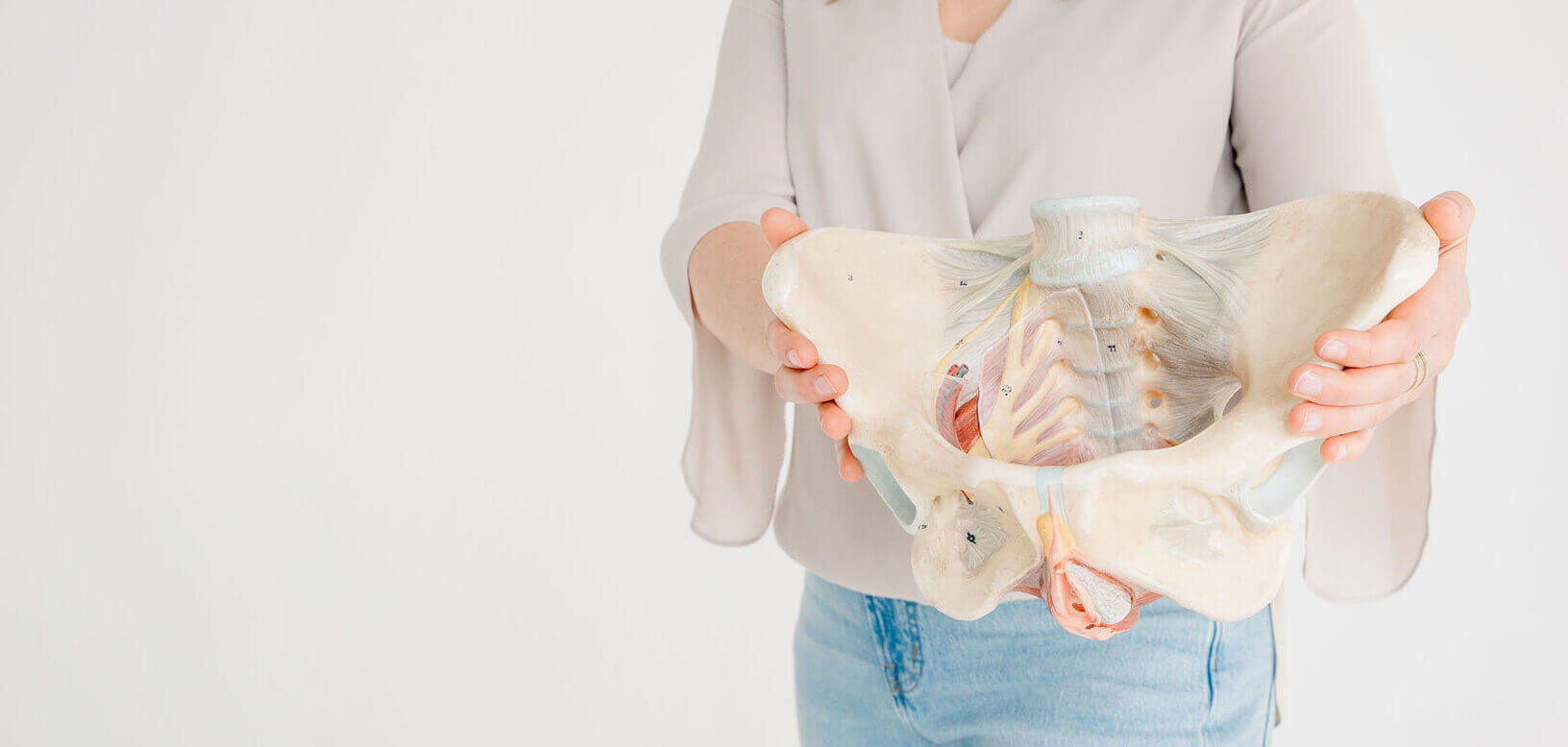
Pelvic and Abdominal Pain
Pelvic Floor Therapy for Pelvic and Abdominal Pain
About Pelvic and Abdominal Pain
Did you know that pelvic pain and abdominal pain can be related to your pelvic floor? Let’s talk about how!
Firstly, the pelvic floor is a group of muscles that each and every person has. They help support your pelvic organs, provide stability and balance to the body, and allow for many functions—urination, defecation, sexual appreciation, pelvic organ support and support of the back and hips.
When these muscles aren’t in working condition, such as being weak, tight, inflexible, or uncoordinated, this creates dysfunction (constipation, pain, and more). But, it is a little more complicated than that. The pelvic floor doesn’t work alone. The pelvic floor is very closely connected with many other structures of the body—including the pelvis, lower back, tailbone, hips, and abdominal muscles.
Your pelvic floor and these surrounding structures are all interconnected—many muscles, tendons, nerves, and ligaments connect your pelvic floor, pelvis, hips, back, and abdominals together. However, for the purpose of unraveling pelvic and abdominal pain, we’ll put extra focus on the pelvis and abdominal muscles.
The muscles and structures of the pelvic floor actually reside within the pelvic bowl, meaning pelvic floor dysfunction greatly affects your pelvis. Additionally, the lowest portion of your abdominals, specifically the transversus abdominis, connects to and contracts in conjunction with your pelvic floor. The connections between the pelvic floor and the abdominals allow for important processes in the body as well as a variety of motions outside the body.
In short, none of these major structures of the body work independently. Instead, they all work together to allow for many different movements and functions! When the pelvic floor, pelvis, and abdominal muscles are all coordinated and in good health, they work together to allow for the following:

- Stabilization: As mentioned earlier, the pelvic floor helps provide stability and balance. They work together with your core muscles and pelvis to support the spine, as well as many of the movements you are capable of doing: turning, twisting, bending, and more.
- Pressure control: When you exercise or lift objects, an internal pressure is created in your core. While engagement of the abdominal muscles seems obvious, the back and pelvic floor muscles play an important role, too. They help support the lifting process and allow you to breathe properly even while the core experiences pressure. When these muscles are weak or uncoordinated, it can cause incontinence, difficulty lifting objects, or even prolapse. Pelvic floor dysfunction can even be created by improper core activation during exercise!
- Breathing: Your abdominals and pelvic floor must work together alongside your diaphragm to allow you to breathe. When any of these muscles become weak, tight, or uncoordinated, you may experience not only difficulty breathing, but also pain, incontinence, and even sexual dysfunction.
- Bowel movements: The pelvic floor and abdominal muscles coordinate to allow for smooth bowel movements and evacuation of stool. However, when these muscles are uncoordinated, it results in pelvic floor dysfunction such as constipation. This can create many other symptoms of abdominal pain, bloating, gas, difficult or painful bowel movements, and more.
- Support during pregnancy: The abdominal muscles, pelvis, and pelvic floor have many important jobs during pregnancy that help support and stabilize the body. However, when these muscles and structures are not coordinated, have weakness, or are inflexible, a pregnant person may experience pelvic floor dysfunction. This can present a variety of symptoms, such as pelvic girdle pain, incontinence, or diastasis recti; to name a few.
- Body posture: The pelvis serves as the center of gravity of the human body, a base for sitting, and a weight distributor. With the support provided by the pelvic floor and abdominal muscles, the pelvis helps provide proper posture and stability for the upper portion of your body (spine, ribs, head, and so on). When the pelvis becomes tilted, it can create harmful postures and pelvic floor dysfunction—which results in symptoms of back pain, hip pain, or urinary incontinence.
As you can see, the pelvic floor is very interconnected to other structures in the pelvis and core. When any of these muscles start to have problems, it can cause many different symptoms in many areas of the body. These symptoms can include any of the following:
- Abdominal pain
- Pelvic pain
- Low back pain
- Tailbone pain
- Constipation
- Difficult or painful bowel movements
- Painful urination
- Incomplete bowel movements or bladder emptying
- Diarrhea
- Urinary or fecal incontinence
- Urinary urgency
- Hemorrhoids
- Sexual dysfunction
- And more
How Pelvic Floor Therapy Can Help
Pelvic floor physical therapy can help relieve your pelvic pain, abdominal pain and other symptoms by addressing your pelvic floor health. Dr. Meihofer is very knowledgeable and experienced with pelvic floor dysfunction, and has seen it all!
She will walk through your symptoms with you, and perform an evaluation with your consent to become more familiar with your pelvic floor. She will determine where the cause of your dysfunction lies—tightness, weakness, inflexibility, incoordination, or a combination. After getting to the root cause of your condition, she’ll craft a unique care plan to improve on the problems you’re experiencing. This can involve techniques to encourage relaxation of your pelvic floor muscles, exercises to strengthen those muscles, and education to help you better understand them.
Getting to the root of your pelvic floor dysfunction is extremely important for long-term relief and pelvic floor health. Someone experiencing abdominal pain, painful bowel movements, and frequent constipation may think they simply need to take laxatives. But medication doesn’t address the cause of that constipation, which can often be tight, overactive, or uncoordinated pelvic floor muscles.
Additionally, some patients may have long-term conditions—like IBD, IBS, chronic constipation, interstitial cystitis, endometriosis, or anismus—that need long-term management. These conditions can not only cause pelvic floor dysfunction, but pelvic floor dysfunction actually worsens the symptoms of those conditions.
In these cases, it may be hard to realize that pelvic floor dysfunction is present. When you experience pain, discomfort, and other symptoms from conditions IBD or endometriosis, it is easy to assume your condition is the only cause of those symptoms.
However, as you experience constant or recurrent pain from these conditions, tension builds in the associated muscles. This creates tension and tightness in your pelvis, pelvic floor, and abdominal muscles. This tension very often results in pelvic floor dysfunction, which will only worsen your pain and symptoms.
Therefore, working with a pelvic floor physical therapist can be extremely beneficial, as only a specialized professional will be able to determine if you have pelvic floor dysfunction, the type of dysfunction you may have, and how to relieve it.
As they help you relieve your pelvic floor dysfunction and muscle tension, you will experience less pain and less severity in the symptoms caused by your condition. While pelvic floor therapy cannot completely heal chronic conditions, it can greatly improve your quality of life by making your symptoms more manageable!
Dr. Meihofer has many years of experience working with chronic conditions and a variety of pelvic floor dysfunctions that create pain. She not only utilizes a variety of treatments to relieve pain, but she also teaches you all you need to know about your body, your condition, and ways to continue symptom management at home.
Dr. Meihofer takes a very holistic approach to treatment, and therefore will also teach you what behavioral and lifestyle modifications may be necessary to prevent future complications, too. If necessary, she can provide additional resources and tools that may help you continue your treatment or management at home! You can learn more about Dr. Laura Meihofer on her bio page.
Dr. Laura Meihofer is an out-of-network provider and does not accept insurance including Medicaid or Medicare. You are responsible for full payment at the time of services. Documentation for out-of-network insurance benefits will be provided upon request.

Choose a Service That’s Best for You!
Dr. Meihofer’s pelvic floor physical therapy for pelvic and abdominal pain can be provided in multiple ways! Explore Dr. Meihofer’s service options below to find one that best fits your health goals, availability, and needs.
You can choose to get started immediately by booking an in-person or telehealth evaluation, or have your questions answered with a free discovery call!
Conditions Related to Pelvic and Abdominal Pain
Not seeing your specific condition or symptom here? No worries, Dr. Meihofer has experience with many different pelvic floor conditions! For questions regarding your unique case, you can schedule a free discovery call to see if pelvic floor therapy is right for you.






